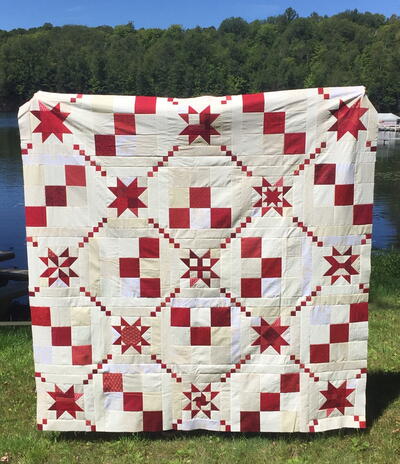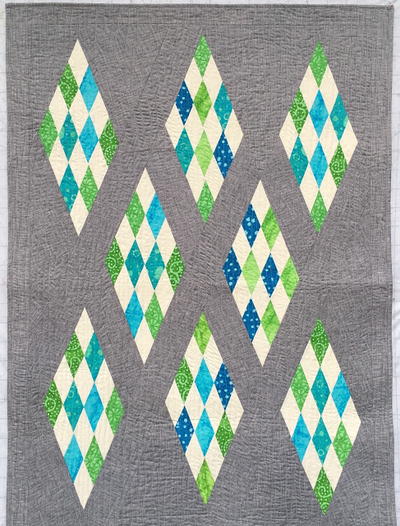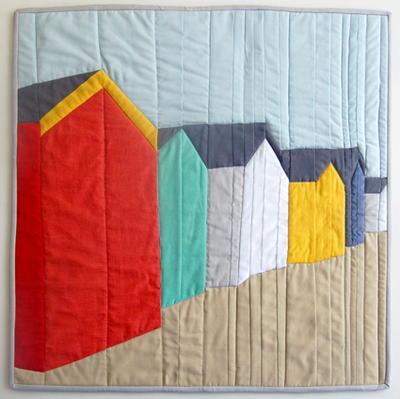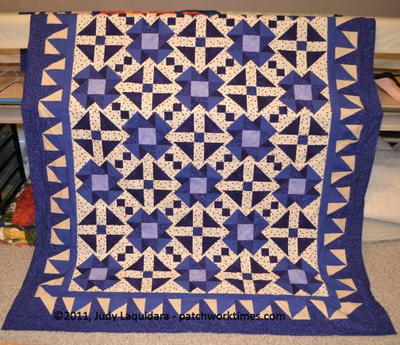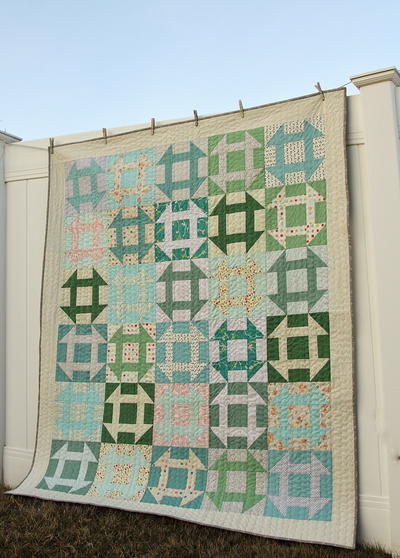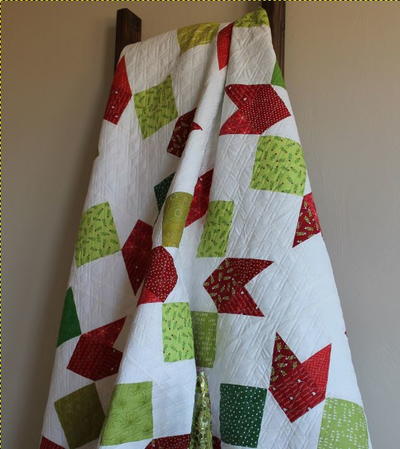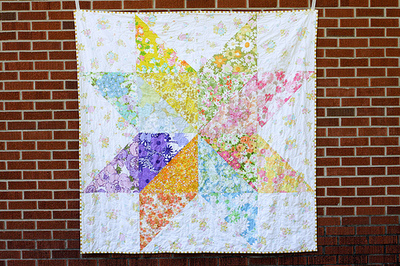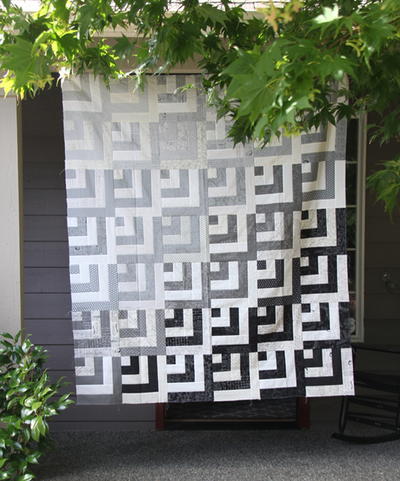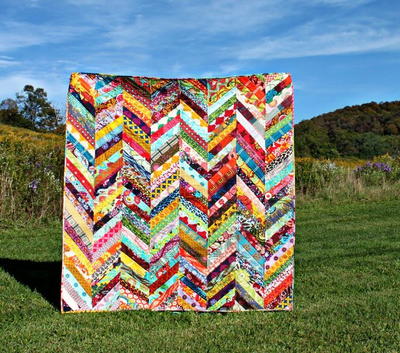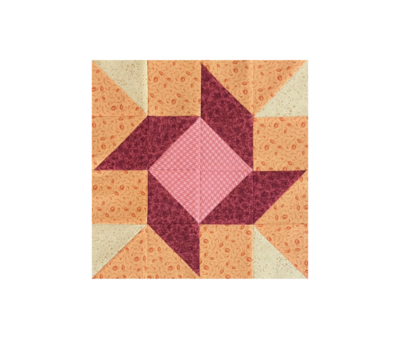Scrappy Stars PDF Quilt Pattern
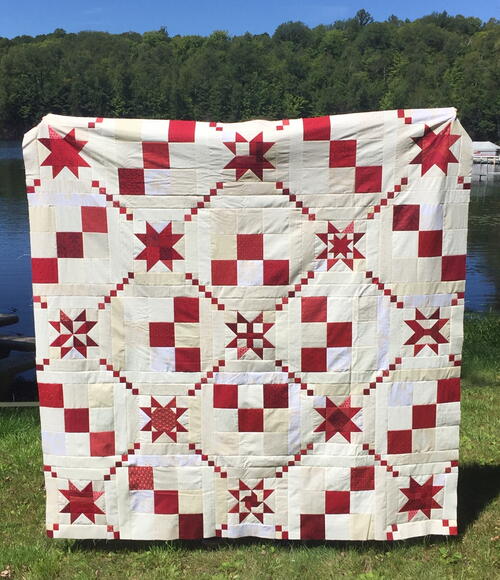
This holiday season, celebrate with an exclusive pattern from our friend, Bonnie Osness from lakegirlquilts.com!
The Scrappy Stars PDF Quilt Pattern uses a variety of red and white print fabric to give this quilt a fun and scrappy feel! The sampling of different centered sawtooth star blocks adds to the charm of this simple quilt pattern. This beginner quilt pattern breaks the project into manageable steps that even a novice quilter can accomplish. Scrappy Stars would be a beautiful quilt to add to your holiday home. Toss it over your couch for a cozy feel that winter begs for. Plus, this quilt is so classic, it's perfect for any month of the year.
Find more pretty patterns from our friend Bonnie over at her blog, Lakegirlquilts.
Click Here to Download the PDF Pattern!
Join Our 100,000+ Fans And Sign Up to Receive Your FREE eNewsletter!
General Sewing Directions
- The directions for this Scrappy Stars quilt are for rotary cutting, machine piecing, and machine quilting -- the binding is hand stitched to the quilt back.
- Accurate cutting and sewing enhances your final product. Pin your pieces together before sewing them to ensure proper seam alignment.
- Use a ¼” seam allowance. I recommend using a special presser foot with a ¼” guide if you have one for your machine. This will help you get uniform seams, and matching corners!
- Follow the pressing directions described in each block.
- The finished quilt measures 72” x 72”.
Fabric Requirements
Use 100% cotton quality fabric for making this quilt. I suggest a variety of fat quarter and/or half-yard red and white/cream fabrics to make this quilt. You can also pull fabrics from your stash, as some blocks have squares as small as 1 ½” x 1 ½”!
Red Fabric - You’ll need a total of about 1 ¾ yards of red fabric to make all the blocks for this quilt.
White Fabric - You’ll need a total of about 3 ¾ yards of white fabric to make all the blocks and sashing for this quilt.
Red Binding Fabric - You’ll need ⅝ yard of 44” red fabric to make the binding for this quilt.
Quilt Back Fabric - You’ll need 4 ½ yards of 44” fabric for the backing of this quilt.
Batting - You’ll need a piece of batting measuring 80” x 80” for this quilt. Use a full-size batting and trim to this size. I suggest a thin, cotton batting like Warm & Natural.
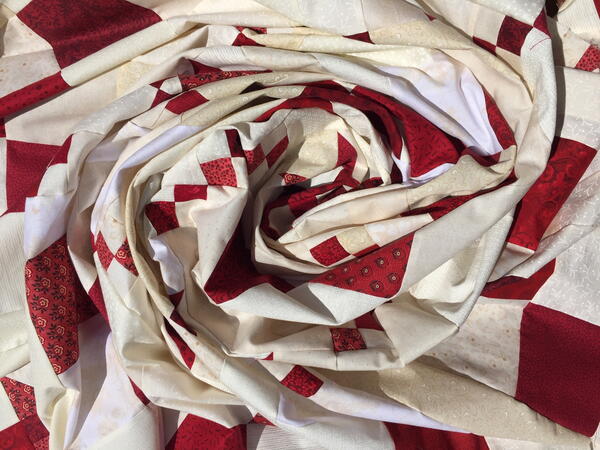
Block Assembly
Sew the individual star block patterns and nine patch blocks. Along with the sashing.
Download the PDF pattern for individual block patterns and sashing here.
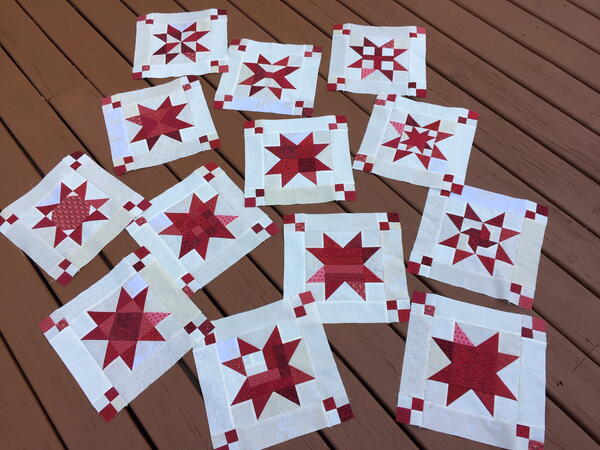
Assemble the Quilt Top
- Follow this diagram to lay out the blocks of your quilt top to form five rows. Each block in a row has a 2 ½” x 12 ½” sashing strip between them. A row of sashing with four patches goes between each block row.
- Sew the blocks and strips of each row together to create five rows. Press the seams to the left. This will allow the seams to nest together when you sew the rows to each other.
- Sew the block rows to each other by sewing a sashing row between them.
Pin at each nested seam and between the seams to hold the rows in place as you sew them together. Remove the pins as you come up to them. Press the seams open.
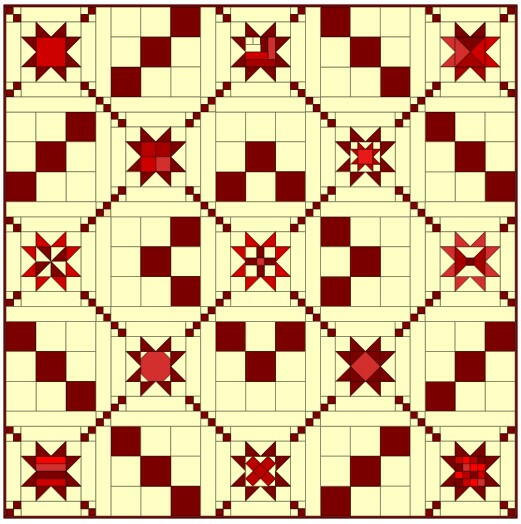
Prepare the Quilt Back, Binding, and Batting
Quilt Back: Fabric requirement is 4 ½ yards of a 44” wide cotton fabric that coordinates with the colors of the quilt top. You’ll need a 80” x 80” square of fabric for the quilt back. This allows for at least 4 inches of fabric to extend all around the edges of the quilt top.
Trim the salvage edges on the quilt back fabric, and cut the 4 ½ yards into 2 – 2 ¼ yard pieces. Place the two pieces right sides together, and sew along the long sides to make one large back. Trim 1” off of the length of the quilt back to measure 80” x 80”. Press the seam open to reduce bulk when quilting.
Binding: You’ll need ⅝ yard of fabric for the binding. Cut 8 – 2 ½” x 44” strips, trim the ends of each strip at opposing 45-degree angles as shown.
Take your 2 ½” binding strips and sew them together. To do this align two strips together perpendicularly along the 45 degree ends. Pin the ends and sew them together. Press the seams open. You’ll need a finished strip that is about 300” (8.3 yards) in total length.
Fold the binding strip in half (wrong sides together), and press.
Batting: Use thin cotton batting (like Warm & Natural) to make this quilt. You’ll need a batting piece at least 80” x 80”. Trim the batting to measure 80” x 80”, the same size as the quilt back. This allows the batting to also extend 4” beyond the edges of the quilt top.
Baste the Quilt Layers
You’ll begin to baste the quilt by sandwiching the top and back with the batting in the middle.
On a large floor area or with two tables pushed together, use masking or painter’s tape to tape down the backing fabric. As you tape the back to the surface, you’ll want to make sure the fabric is smooth, without wrinkles. Make sure the back is taped taut, but not stretched. Also, make sure the right side of the fabric is facing down!
Lay the batting on top of the taped-down quilt back, and move your hands across it to smooth it all over. This will get rid of any wrinkles in the batting, and help to adhere it to the backing fabric.
Once you have the batting placed on top of the quilt back, center the top of the quilt over the two bottom layers. Right side facing up, of course! The two bottom layers of the quilt (the back and the batting) should extend about 4” all around the outside edges of the quilt top.
Move your hands across the quilt top to smooth it all over, and help remove any wrinkles. This will also help adhere the quilt top to the batting a little bit. Once you have the top of the quilt all smoothed out, either use basting spray or use 1 ½” stainless pins to baste your quilt layers together. You’ll want to start basting on one side of the quilt, and work your way across, or work from top to bottom. If pinning, you should place a pin about every 4 inches or so.
Quilting and Binding
If you are machine quilting this quilt yourself, choose a quilting design to permanently join all three layers of the Scrappy Stars quilt together.
Using a darning foot and dropping the feed dogs on your sewing machine allows you to free motion stitch the quilt layers together. If you’re new to machine quilting you might want to search for online videos that can demonstrate the process for you.
When you’ve finished quilting the layers together, it’s time to bind the edges of your quilt! This could be a lesson in itself!! I’ll do my best to describe the binding process below, but if you’re confused by my directions there are lots of videos on the Internet that will demonstrate the process for you.
Sew the Binding Strip to the Quilt
Begin to sew the raw edge of the binding to the quilt by pinning it along one side. Be careful to sew the raw edge of the binding strip to the quilt, not the folded edge!
I usually start sewing the binding strip in the middle of the quilt side that I’m starting with. Start sewing about 5” in from the end of the binding strip, leaving a hanging “tail” on the binding. You’ll sew this to the other end of the binding strip when you finish sewing all along the sides of the quilt.
Stop sewing on the first side ¼” from the corner, use a pin to mark this location and sew right up to it. Backstitch a bit, and cut your thread but DON’T cut the binding strip.
Making the Mitered Corner
Now, remove the quilt and binding strip from your machine and fold the binding strip straight up so it’s perpendicular from the side you were just sewing on.
Fold the binding strip back down on itself and match it to the edge of the quilt you just sewed it to, and the next edge of the quilt you’re about to sew it to. Pin this fold in place, and pin the binding strip to this edge of the quilt and continue to sew it, again stopping ¼” from the next corner and repeating the folding process described above.
Continue in this manner until you are on the last side of the quilt, the side you started on.
Connecting the Ends of the Binding
Stop stitching about 4” from where you started. Backstitch and cut the thread (but not the binding strip, not yet!), remove the quilt and binding strip from the machine.
You now have two “tails” of the binding strip, one from where you started stitching it to the quilt and one from where you just stopped.
You’ll need to join these tails together so that you have a continuous binding strip to finish sewing down to the quilt. This can be tricky!
I don’t worry now about cutting 45-degree angles on each end of the binding strip to sew it together to make a continuous strip. If you can master this technique, my hat is off to you!! What I do is measure how much more binding strip I’ll need to finish sewing it to the edge of the quilt. I then cut a straight line along each end of the binding strip, adding ¼” to each end so I can sew the ends together with a ¼” seam (right sides together). Continue to sew the now continuous binding strip to the quilt.
Trim the Batting and Back
Trim the batting and quilt back to ¼” from the edge of the quilt top. I use a ruler and a rotary cutter to accomplish this task. Work carefully, so you don’t cut into your quilted project.
Hand-Stitch the Folded Binding Edge to the Quilt Back
Here is my FAVORITE part of the process…almost done! Hand-sew the folded edge of the binding strip to the back of the quilt. When you get to the corner, carefully turn the corner right-side out to make a nice, mitered corner. I tack a few stitches up the corner to hold it in place, and then continue stitching along all sides and corners until…VOILA! Your binding is complete!
As a finishing touch, you can add a label to the back of the quilt. A quilt label is like the signature on your masterpiece!!
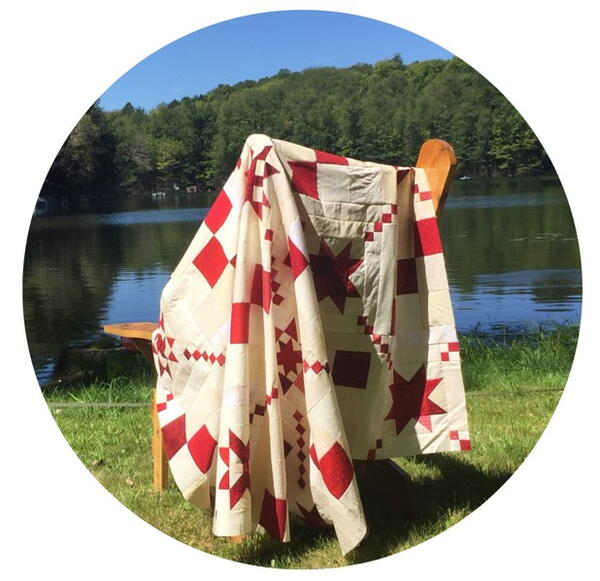
Read NextGrayscale Jelly Roll Quilt Tutorial

